Wilhelmina of the Netherlands
| Wilhelmina | |
|---|---|
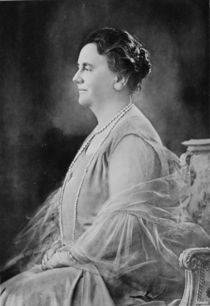 |
|
| Queen Wilhelmina in 1942 | |
|
|
|
| Reign | 23 November 1890 – 4 September 1948 (57 years, 286 days) |
| Predecessor | William III |
| Successor | Juliana |
| Regent | Emma of Waldeck and Pyrmont (1890-1898), Juliana (1947, 1948) |
| Spouse | Henry of Mecklenburg-Schwerin |
| Issue | |
| Juliana of the Netherlands | |
| Full name | |
| Wilhelmina Helena Pauline Maria | |
| House | House of Orange-Nassau |
| Father | William III of the Netherlands |
| Mother | Emma of Waldeck and Pyrmont |
| Born | 31 August 1880 The Hague, Netherlands |
| Died | 28 November 1962 (aged 82) Apeldoorn, Netherlands |
| Burial | 8 December 1962 Nieuwe Kerk, Delft |
| Religion | Reformed Protestant |
Wilhelmina (Wilhelmina Helena Pauline Maria; 31 August 1880 - 28 November 1962) was Queen regnant of the Kingdom of the Netherlands from 1890 to 1948. She ruled the Netherlands for fifty-eight years, longer than any other Dutch monarch. Her reign saw World War I and World War II, the economic crisis of 1933, and the decline of the Netherlands as a major colonial empire. Outside the Netherlands she is primarily remembered for her role in World War II, in which she proved to be a great inspiration to the Dutch resistance.
Contents |
Early life
Princess Wilhelmina Helena Pauline Maria of the Netherlands, Princess of Orange-Nassau, was born on 31 August 1880 in The Hague, Netherlands. She was the only child of King William III and his second wife, Emma of Waldeck and Pyrmont. Her childhood was characterised by a close relationship with her parents, especially with her father, who was 63 years of age when she was born.
King William III had three sons with his first wife, Sophie of Württemberg. However, when Wilhelmina was born, William had already outlived two of them and only the childless Prince Alexander and the King's uncle Prince Frederick of the Netherlands were alive, so under the Semi-Salic system of inheritance that was in place in the Netherlands until 1887, she was third in line to the throne from birth. When Prince Frederick died a year later in 1881, she became second in line. When Wilhelmina was four, Alexander died and the young girl became heiress presumptive.
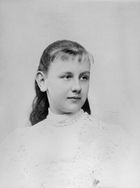
King William III died on 23 November 1890, and, although Princess Wilhelmina became Queen of the Netherlands instantly, her mother, Emma, was named regent. In 1895, Queen Wilhelmina visited Queen Victoria of the United Kingdom, who penned a crisp evaluation in her diary:
The young Queen ... still has her hair hanging loose. She is slender and graceful, and makes an impression as a very intelligent and very cute girl. She speaks good English and knows how to behave with charming manners.[1]
Wilhelmina was enthroned on 6 September 1898.[2] On 7 February 1901 in The Hague, she married Duke Henry of Mecklenburg-Schwerin.
Wilhelmina suffered miscarriages in 1901 and 1906, and gave birth to a stillborn son in 1902.[3] The birth of Juliana, on 30 April 1909, was met with great relief after eight years of childless marriage.[4] Wilhelmina suffered two further miscarriages in 1912.[3]
Reign
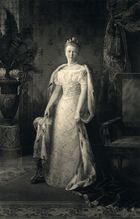
| Royal styles of Wilhelmina of the Netherlands |
|
|---|---|
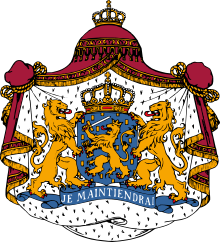 |
|
| Reference style | Her Majesty |
| Spoken style | Your Majesty |
| Alternative style | Ma'am |
Tactful, and careful to operate within the limitations of what was expected by the Dutch people and their elected representatives, the strong-willed Wilhelmina became a forceful personality who spoke and acted her mind. These qualities showed up early on in her reign when, at the age of 20, Queen Wilhelmina ordered a Dutch warship to South Africa to rescue Paul Kruger, the embattled President of the Transvaal.
Wilhelmina had a stern dislike of the United Kingdom, which had annexed the republics of Transvaal and Orange Free State in the Boer War. The Boers were descendants of early Dutch colonists, to whom Wilhelmina felt very closely linked. Nevertheless, in 1940, King George VI sent the warship HMS Hereward, to rescue Wilhelmina, her family and her Government and bring them to safety in the UK, which offered facilities including broadcasting time on the BBC to the Netherlands.
Queen Wilhelmina also had a keen understanding of business matters and her investments made her the world's richest woman, a status retained by her daughter and by her granddaughter, Queen Beatrix.
Prior to the outbreak of the First World War, the young Wilhelmina visited the powerful German Emperor William II, who boasted to the Queen of a relatively small country, "my guards are seven feet tall and yours are only shoulder-high to them." Wilhelmina smiled politely and replied, "Quite true, Your Majesty, your guards are seven feet tall. But when we open our dikes, the water is ten feet deep!"[5]
World War I
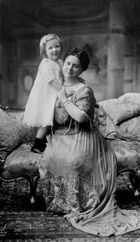
The Netherlands remained neutral during World War I. However, the Allies included the Netherlands in their blockade of Germany, intercepting all Dutch ships and severely restricting Dutch imports to insure goods could not be passed on to Germany.
Wilhelmina was a "soldier's queen"; being a woman, she could not be Supreme Commander, but she nevertheless used every opportunity she had to inspect her forces. On many occasions she appeared without prior notice, wishing to see the reality, not a prepared show. She loved her soldiers, and was very unhappy with most of her governments, which were always eager to cut the military budget. Wilhelmina wanted a small but well trained and equipped army.
In the war, she felt she was a "Queen-On-Guard". She was always wary of a German attack, especially in the beginning. However, the chief violation of Dutch sovereignty was the Allied blockade.
Civil unrest gripped the Netherlands after the war, spurred by the 1917 Bolshevik revolution in Russia. Socialist leader Pieter Jelles Troelstra wanted to abolish the existing government and the monarchy. Instead of a violent revolution, he hoped to do this by winning control of Parliament in an election, supported by the working class. However, the popularity of the young Queen helped restore confidence in the government. Wilhelmina brought about a mass show of support by riding with her daughter through the crowds in an open carriage.
At the end of World War I, Kaiser Wilhelm fled to the Netherlands, where he was granted political asylum, partly owing to his family links with Queen Wilhelmina. In response to Allied efforts to get their hands on the deposed Kaiser, Wilhelmina called the Allies' ambassadors to her presence and lectured them on the rights of asylum.[6]
Between the wars

During the 1920s and 1930s, the Netherlands began to emerge as an industrial power. Engineers reclaimed vast amounts of land that had been under water by building the Zuiderzee Works. The death of Wilhelmina's husband, Prince Hendrik, in 1934 brought an end to a difficult year that also saw the passing of her mother Queen Emma.
The interbellum, and most notably the economic crisis of the 1930s, was also the period in which Wilhelmina's personal power reached its zenith; under the successive governments of a staunch monarchist prime minister, Hendrik Colijn (ARP), Wilhelmina was deeply involved in most questions of state.
In 1939, Colijn's fifth and last government was swept away by a vote of no confidence two days after its formation. It is widely accepted that Wilhelmina herself was behind the formation of this last government, which was designed to be an extra-parliamentary or 'royal' cabinet. The Queen was deeply skeptical of the parliamentary system and tried to bypass it covertly more than once.
She also arranged the marriage of her daughter Juliana to Prince Bernhard of Lippe-Biesterfeld, a German aristocrat. Although it was claimed that he was initially a supporter of the Nazi regime, no hard evidence of this has ever been found or publicized. The prince however, was a member of the Nazi Party and of the so-called Reiter-SS (SS Cavalry Corps), as was proved by the Dutch national institute for war documentation, NIOD.
In 1939, the government proposed a refugee camp for German Jews fleeing the Nazi regime. Wilhelmina intervened, as she felt the planned location was "too close" to her summer residence. The camp was finally erected about 10 km from the village of Westerbork.
World War II
On 10 May 1940, Nazi Germany invaded the Netherlands. Queen Wilhelmina had wanted to stay in the Netherlands: she had planned to go to the southern province of Zeeland with her troops in order to coordinate further resistance from the town of Breskens and remain there until help arrived, much as King Albert I of Belgium had done during World War I. She fled The Hague, and she boarded HMS Hereward, a British destroyer which was to take her south;[7] however, after she was aboard, Zeeland came under heavy attack from the Luftwaffe and it was considered too dangerous to return. Wilhelmina was then left with no option but to accept George VI's offer of refuge. She retreated to Britain, planning to return as soon as possible.[8]
The Dutch armed forces in the Netherlands, apart from those in Zeeland, surrendered on 15 May. In Britain, Queen Wilhelmina took charge of the Dutch government in exile, setting up a chain of command and immediately communicating a message to her people.
Relations between the Dutch government and the Queen were tense, with mutual dislike growing as the war progressed. Wilhelmina went on to be the most prominent figure, owing to her experience and knowledge. She was also very popular and respected among the leaders of the world. The government did not have a parliament to back them and had few employees to assist them. The Dutch prime minister Dirk Jan de Geer, believed the Allies would not win and intended to open negotiations with the Nazis for a separate peace. Therefore Wilhelmina sought to remove Jan de Geer from power. With the aid of a minister, Pieter Gerbrandy, she succeeded.
During the war her photograph was a sign of resistance against the Germans. Like Winston Churchill, Queen Wilhelmina broadcast messages to the Dutch people over Radio Oranje.
The Queen called Adolf Hitler "the arch-enemy of mankind". Her late-night broadcasts were eagerly awaited by her people, who had to hide in order to listen to them illegally. An anecdote published in her New York Times obituary illustrates how she was valued by her subjects during this period:
Although celebration of the Queen’s birthday was forbidden by the Nazis, it was commemorated nevertheless. When churchgoers in the small fishing town of Huizen rose and sang one verse of the Dutch national anthem, Wilhelmus van Nassauwe, on the Queen’s birthday, the town paid a fine of 60,000 guilders.[1]
Queen Wilhelmina visited the United States from 24 June–11 August 1942 as guest of the U.S. government. She vacationed in Lee, Massachusetts, visited New York City, Boston, and Albany, New York. She addressed the U.S. Congress on 5 August 1942, and was the first queen to do so.
Queen Wilhelmina went to Canada in 1943 to attend the christening of her grandchild Princess Margriet on 29 June 1943 in Ottawa and stayed a while with her family before returning to England.
During the war, the Queen was almost killed by a bomb that took the lives of several of her guards and severely damaged her country home near South Mimms in England. In 1944 Queen Wilhelmina became only the second woman to be inducted into the Order of the Garter. Churchill described her as the only real man among the governments-in-exile in London.
In England, she developed ideas about a new political and social life for the Dutch after the liberation. She wanted a strong cabinet formed by people active in the resistance. She dismissed De Geer during the war and installed a prime minister with the approval of other Dutch politicians. The Queen "hated" politicians, instead stating a love for the people. When the Netherlands was liberated in 1945 she was disappointed to see the same political factions taking power as before the war. Prior to the end of the war, in mid-March 1945, she travelled to the Allied occupied areas of the south of the Netherlands visiting the region of Walcheren and the city of Eindhoven where she received a rapturous welcome from the local population.[9]
Following the end of World War II, Queen Wilhelmina made the decision not to return to her palace but move into a mansion in The Hague, where she lived for eight months, and she travelled through the countryside to motivate people, sometimes using a bicycle instead of a car. However, in 1947, while the country was still recovering from World War II, the revolt in the oil-rich Dutch East Indies saw sharp criticism of the Queen by the Dutch economic elite.
Around the same time, Wilhelmina's health started failing her. Bad health caused her to cede the throne to her daughter Juliana temporarily towards the end of 1947 (October 14 through December 1). She considered abdication but Juliana pressed her to stay on for the stability of the nation, urging her to complete 50 years on the throne. Wilhelmina tried to comply, but exhaustion forced her to cede the throne again on May 12, 1948. This time the timing was unfortunate, as it left Juliana to deal with the early elections due to the ceding of the Indonesian colonies.
Wilhelmina kept her promise to her daughter formally, remaining queen formally until September 4. Then, being extremely disappointed about the return to pre-war politics, she abdicated.
She was the 896th Dame of the Order of the Garter in 1944.
Later years
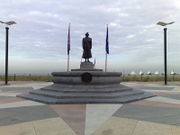
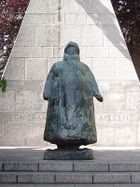
As of 1948, Wilhelmina was the only survivor of the 16 European kings and one queen who were sitting on their thrones at the time of her coronation in 1898. The Dutch Royal Family was also one of seven European royal houses remaining in existence.[10]
On 4 September 1948, after a reign of 57 years and 286 days, Wilhelmina abdicated in favour of her daughter Juliana, because of advancing old age and illness which had already caused two regencies, and the strain of the war years. She was thenceforward styled "Her Royal Highness Princess Wilhelmina of the Netherlands". After her reign, the influence of the Dutch monarchy began to decline but the country's love for its royal family continued. No longer queen, Wilhelmina retreated to Het Loo Palace, making few public appearances until the country was devastated by the North Sea flood of 1953. Once again she travelled around the country to encourage and motivate the Dutch people.
During her last years she wrote her autobiography entitled Eenzaam, maar niet alleen (Lonely but Not Alone), in which she gave account of the events in her life, and revealed her strong religious feelings and motivations.
Queen Wilhelmina died in Het Loo at the age of 82 on 28 November 1962, and was buried in the Dutch Royal Family crypt in the Nieuwe Kerk in Delft, on 8 December. The funeral was, at her request and contrary to protocol, completely in white to give expression to her belief that earthly death was the beginning of eternal life.[11]
Had Wilhelmina not given the throne to her daughter before her death, she would have reigned for 72 years 5 days, which would have been the second-longest reign in Europe (behind that of Louis XIV of France), seventh-longest in the world, and the longest reign by a female monarch in history.
Titles
- Her Royal Highness Princess Wilhelmina of the Netherlands, Princess of Orange-Nassau (1880–1890)
- Her Majesty The Queen of the Netherlands (1890–1948)
- Her Royal Highness Princess Wilhelmina of the Netherlands, Princess of Orange-Nassau, Duchess of Mecklenburg[12] (1948–1962)
Ancestry
| Ancestors of Wilhelmina of the Netherlands | ||||||||||||||||||||||||||||||||||||||||||||||||||||||||||||||||||||||||||||||||||||||||||||||||||||||||||||||||||||||||||||||||||||||||||||||||||||||||||||||||||||||||||||||||||||||||||||||||||||||||||||||||||||||||||||||||||||||||||||||||||||||||||||||||||||||||||||||||||||||||||||||||||||||||||||||||||||||||||||||||||||||||||||||||||||||||||||||||||||||||||||||||||||||||||||||||||||||||||||||||||||||||||||||||||||||||||||||||||||||||||||||||||||||||||||||||||||||||||||||||||||||||||||||||||||||||||||||||||||||||||||||||||||||||||||||||||
|---|---|---|---|---|---|---|---|---|---|---|---|---|---|---|---|---|---|---|---|---|---|---|---|---|---|---|---|---|---|---|---|---|---|---|---|---|---|---|---|---|---|---|---|---|---|---|---|---|---|---|---|---|---|---|---|---|---|---|---|---|---|---|---|---|---|---|---|---|---|---|---|---|---|---|---|---|---|---|---|---|---|---|---|---|---|---|---|---|---|---|---|---|---|---|---|---|---|---|---|---|---|---|---|---|---|---|---|---|---|---|---|---|---|---|---|---|---|---|---|---|---|---|---|---|---|---|---|---|---|---|---|---|---|---|---|---|---|---|---|---|---|---|---|---|---|---|---|---|---|---|---|---|---|---|---|---|---|---|---|---|---|---|---|---|---|---|---|---|---|---|---|---|---|---|---|---|---|---|---|---|---|---|---|---|---|---|---|---|---|---|---|---|---|---|---|---|---|---|---|---|---|---|---|---|---|---|---|---|---|---|---|---|---|---|---|---|---|---|---|---|---|---|---|---|---|---|---|---|---|---|---|---|---|---|---|---|---|---|---|---|---|---|---|---|---|---|---|---|---|---|---|---|---|---|---|---|---|---|---|---|---|---|---|---|---|---|---|---|---|---|---|---|---|---|---|---|---|---|---|---|---|---|---|---|---|---|---|---|---|---|---|---|---|---|---|---|---|---|---|---|---|---|---|---|---|---|---|---|---|---|---|---|---|---|---|---|---|---|---|---|---|---|---|---|---|---|---|---|---|---|---|---|---|---|---|---|---|---|---|---|---|---|---|---|---|---|---|---|---|---|---|---|---|---|---|---|---|---|---|---|---|---|---|---|---|---|---|---|---|---|---|---|---|---|---|---|---|---|---|---|---|---|---|---|---|---|---|---|---|---|---|---|---|---|---|---|---|---|---|---|---|---|---|---|---|---|---|---|---|---|---|---|---|---|---|---|---|---|---|---|---|---|---|---|---|---|---|---|---|---|---|---|---|---|---|---|---|---|---|---|---|---|---|---|---|---|---|---|---|---|---|---|---|---|---|---|---|---|---|---|---|---|---|---|---|---|---|---|---|---|---|---|---|---|---|---|---|---|---|---|---|---|---|---|---|---|---|---|---|---|---|---|---|---|---|---|---|---|---|---|---|---|---|---|---|---|---|---|---|---|---|---|---|---|---|---|---|---|---|---|---|---|---|---|---|---|---|---|---|---|---|---|---|---|---|---|---|---|---|---|---|---|---|---|---|---|
|
||||||||||||||||||||||||||||||||||||||||||||||||||||||||||||||||||||||||||||||||||||||||||||||||||||||||||||||||||||||||||||||||||||||||||||||||||||||||||||||||||||||||||||||||||||||||||||||||||||||||||||||||||||||||||||||||||||||||||||||||||||||||||||||||||||||||||||||||||||||||||||||||||||||||||||||||||||||||||||||||||||||||||||||||||||||||||||||||||||||||||||||||||||||||||||||||||||||||||||||||||||||||||||||||||||||||||||||||||||||||||||||||||||||||||||||||||||||||||||||||||||||||||||||||||||||||||||||||||||||||||||||||||||||||||||||||||
See also
- Dutch monarchs family tree
References
- General
- Hubbard, Robert H. (1977). Rideau Hall: An Illustrated History of Government House, Ottawa, from Victorian Times to the Present Day. Montreal: McGill-Queen's University Press. 10-ISBN 0-773-50310-2; 13-ISBN 978-0-773-50310-6
- Wilhelmina. (1959). Eenzaam maar niet alleen. Amsterdam: Ten Have Uitgevers Kok. 10-ISBN 9-025-95146-5; 13-ISBN 978-9-025-95146-7
- Specific
- ↑ 1.0 1.1 "Wilhelmina of Netherlands Dies" (UPI), New York Times, 28 November 1962. pp. A1–A39.
- ↑ "Dictionary of American Naval Fighting Ships: Wilhelmina". United States Navy. http://www.history.navy.mil/danfs/w8/wilhelmina.htm. Retrieved 10 October 2009.
- ↑ 3.0 3.1 Genealogy of the Royal Family of the Netherlands
- ↑ http://www.rnw.nl/obituary/en/html/juliana.html
- ↑ "Caged no more" Time. 7 December 1962.
- ↑ "Worried Queen", Time. 27 November 1939.
- ↑ Holland's Queen Barely Escaped," The Evening Independent (St. Petersburg, Florida). 17 May 1940; Wagner, Margaret et al. (2007). The Library of Congress World War II Companion, p. 77–78.
- ↑ Reston, James R. "Queen Wilhelmina goes to England," New York Times. 14 May 1940.
- ↑ Henri A. van der Zee, The Hunger Winter: Occupied Holland 1944–1945, University of Nebraska Press, 1998, pp. 200–203.
- ↑ "Queen Wilhelmina". Life 25 (7): 83. 16 August 1948. ISSN 0024-3019. http://books.google.com/books?id=1UcEAAAAMBAJ.
- ↑ Wilhelmina; Eenzaam maar niet alleen, p. 251.
- ↑ http://www.parlement.com/9291000/biof/10010
External links
- Royal House of the Netherlands and Grand-Ducal House of Luxembourg
- Grand-Ducal House of Mecklenburg-Schwerin
- Queen Wilhelmina (1880-1962) at The Dutch Royal House website
- Queen Wilhelmina State Park near Mena, Arkansas
| Wilhelmina_van_Oranje-Nassau_(1880-1962) on Familypedia |
|
Wilhelmina of the Netherlands
Cadet branch of the House of Nassau
Born: 31 August 1880 Died: 28 November 1962 |
||
| Regnal titles | ||
|---|---|---|
| Preceded by William III |
Queen of the Netherlands 1890–1948 |
Succeeded by Juliana |
| Dutch royalty | ||
| Preceded by Alexander, Prince of Orange |
Heir to the Dutch throne as heiress presumptive 1884–1890 |
Succeeded by William Ernest |
|
|||||
|
|||||||||||||||||||||||